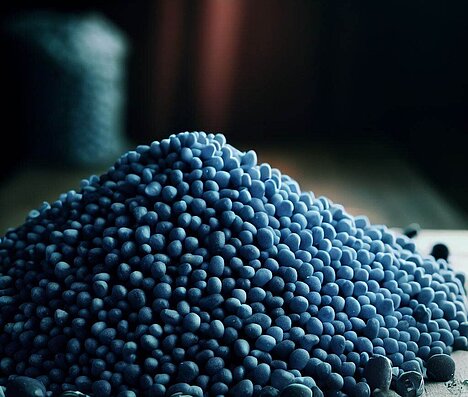Blue grain

What is blue grit?
Blue grain is a mineral fertilizer that consists of various salts, primarily nitrates. Nitrates are salts of nitric acid and contain nitrogen, which plants need to grow. Blue grit has a typical blue color and is usually offered as granules or powder.
Is blue grit poisonous for dogs?
Blue grit is poisonous for dogs! Contrary to the widespread opinion that mineral fertilizers are harmless, blue corn can be deadly for dogs. For this to happen, the dog must ingest the chemicals in high concentrations. This can happen, for example, if he
- eats directly from a packet or bucket of blue corn
- drinks from a puddle that is contaminated with blue grit
- licks its paws that have come into contact with blue corn.
The toxicity of blue corn depends on the amount ingested and the dog's body weight. Puppies and small dogs are particularly at risk. The nitrate contained in blue corn is converted to nitrite in the body, which interferes with oxygen transport in the blood. This can lead to severe symptoms such as respiratory distress, cyanosis (blue coloration of the mucous membranes), convulsions or heart failure.
How do I recognize cyanide poisoning in dogs?
Blue corn poisoning in dogs can manifest itself through various signs. The most common are
- Vomiting
- diarrhea
- salivation
- trembling
- weakness
- restlessness
- wheezing
- Blue tongue or lips
If you suspect that your dog has eaten or come into contact with bluetongue, you should consult a vet immediately. Quick treatment can save lives!
How can I protect my dog from blue corn poisoning?
The best way to prevent blue corn poisoning in dogs is to avoid contact with the fertilizer. This can be achieved by the following measures
- Do not use artificial fertilizers such as blue corn in the garden or on the balcony. There are non-toxic alternatives such as compost or horn shavings.
- Keep the fertilizer out of your dog's reach. Seal the packets tightly and keep them out of his reach.
- Watch out for fertilized fields or meadows on walks and keep your dog away from them. Put him on a lead and lead him out of the danger zone.
- Check his paws regularly after the walk and clean them of dirt or fertilizer residue if necessary.
- Always give your dog fresh water to drink and avoid puddles at the side of the path.
Blue grain is an artificial fertilizer that is toxic to dogs and can lead to life-threatening poisoning.
Properties 3
Are you looking for other ingredients with a specific property?
Just click on them to find more.
If you notice any signs of hypersensitivity or poisoning in your dog, you should see your vet immediately. We are not a substitute for a vet, but we try to be as accurate as possible. Every dog reacts differently and we recommend you get a second opinion or consult your vet if in doubt.
Stay healthy and take good care of your four-legged friend!😊
Similar to Blue grain
Nitrogen fertilizer is a fertilizer that primarily contains nitrogen (N), an important element for plant growth. Nitrogen is a component of chlorophyll, the green pigment in the leaves that is...
Potassium fertilizer is a fertilizer that consists mainly of potassium salts. There are various types of potassium fertilizers that differ in their composition, effect and application. The most...
Phosphate fertilizers are available in various forms and compositions. Some are mineral, others organic or organic-mineral. The most important phosphate fertilizers are Superphosphate: A mineral...
Compost fertilizer is the result of a natural decomposition process of organic materials such as kitchen and garden waste. Through the activity of microorganisms, fungi and worms, this waste is...



